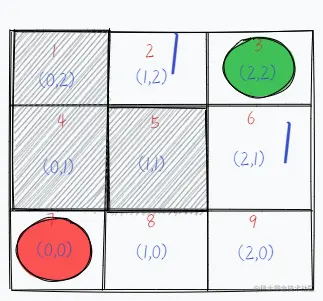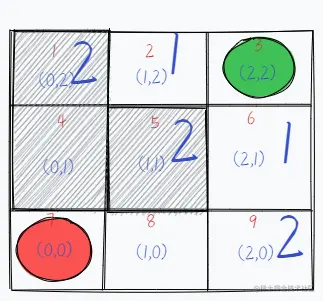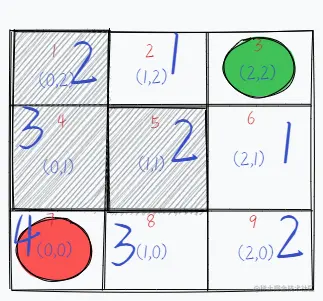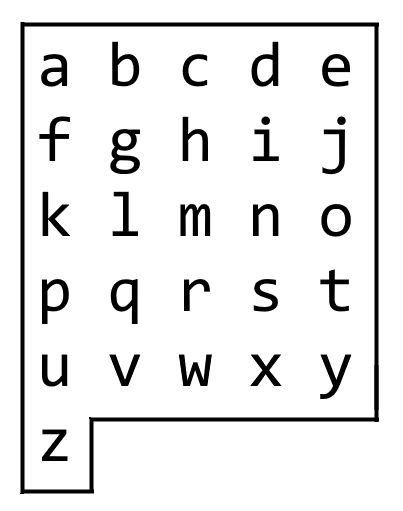# DFS
Depth first search 成为」深度优先遍历「
下面结合具体例子来理解。如图所示,在一个九宫格图中,绿色位置代表起始位置,红色位置代表重点位置,灰色区域和宫格图的边界代表此路不通,请从起始位置按照每次只能移动一格的方法移动到终点位置

我们用DFS的方法去解这道题,由图可知,我们可以走上下左右四个方向,我们不妨先约定"左>上>右>下"的顺序走,即,如果左边可以走,我们先走左边。然后」递归「下去,没达到终点,我们在原路返回,等又返回到这个位置时,左边已经走过了,那么我们就走上面,按照这个顺序走。并且我们把走过的路(方向)作为标记表示"不能走回头路"
按照约定,我们先从起点首先向左走到位置2,这时发现左边不能走了,这时我们就考虑往上走,发现也不能走,同理,下面也不能走。按照约定,我们先从起点首先向左走到位置 2,这时发现左边不能走了,这时我们就考虑往上走,发现也不能走,同理,下边也不能走。右边刚才已经走过了也不能走,这时候无路可走了,代表这条路不能通往终点,所以现在「无路可走」的时候,沿着原路返回,直到回到了还有未走过的路的路口,尝试继续走没有走过的路径。
于是我们只有回到最初的位置 1,然后判断左边刚才已经走过了并且证实这个方向行不通,那就不必走了,上和右也是不通,所以我们走下边。于是走到了 6 的位置,此时还是按照约定“左>上>右>下” 的顺序走,左边和右边依然不通,上边刚才已经走过了,所以得继续往下走。 继续往下那就是位置 9 了,到了这个路口我们继续按照约定“左>上>右>下” 的顺序,先往左发现可以走,那么就继续走到位置 8,到了位置 8 还是按照刚才的思路继续往左,发现还可以走,并且最终到达终点位置 7。 综上所述,这个过程就是「深度优先遍历」。
DFS的重点在于状态回溯,因此我们做个思路总结:
- 深度优先遍历 只有前面有可以走的路,就会一直向前走,直到五路可走才会回头
- 」无路可走「有两种情况:① 遇到了墙;②遇到了已经走过的路
- 在」无路可走「的时候,沿着原路返回,直到回到了还有未走过的路的路口,尝试继续走没有走过的路径;
- 有一些路径没有走到,这是因为找到了出口,程序就停止了
- 」深度优先遍历「也叫」深度优先搜索「,遍历是行为的描述,搜索是目的(用途)
- 遍历不是很深奥的事情,把所有的可能情况都遍历一遍,才能说」找到了目标元素「或者」没有找到目标元素「。遍历也叫穷举,穷举的思想在人类看来虽然很不起眼,但借助计算机强大的计算能力,穷举可以帮助我们解决很多专业领域知识不能解决的问题。
使用DFS来解答刚才题目的代码如下
// 我们以红点位置为坐标{0, 0},绿色位置坐标为{2,2}
// 目标的坐标位置
let target = {
x: 0,
y: 0
}
// 绿色起点坐标位置
let currentLocation = {
x: 2,
y: 2
}
let used = []; // 用来标记地图上哪些点是走过的
let reached = false; //是否能到达目标位置
// 表示灰色区域的格子
const illegalLocation = [
{ x: 0, y: 2 }, // 序号1的坐标
{ x: 0, y: 1 }, // 序号4的坐标
{ x:1, y: 1} // 序号5的坐标
]
function isLegalLocation({x, y}, illegalLocation) {
let flag = true;
// 位置不能在地图坐标之外
if(x < 0 || x > 2 || y < 0 || y > 2) {
return (flag = false);
}
// 不能走的路径
for(const { x: locX, y: locY } of illegalLocation) {
if(x === locX && y === locY) {
flag = false;
}
}
return flag;
}
//向左移动
function toLeft({ x, y }) {
return { x: x - 1, y };
}
//向上移动
function toTop({ x, y }) {
return { x, y: y + 1 };
}
//向右移动
function toRight({ x, y }) {
return { x: x + 1, y };
}
//向下移动
function toBottom({ x, y }) {
return { x, y: y - 1 };
}
function dfs(target, location, illegalLocation, used) {
// 如果当前位置与目标坐标相同表示可以达到
if(Object.entries(target).toString() === Object.entries(location).toString()) {
return (reached = true);
}
let current = location;
const newIllegalLocation = illegalLocation.concat(used);
if(isLegalLocation(toLeft(location), newIllegalLocation)) {
current = toLeft(location);
} else if(isLegalLocation(toTop(location), newIllegalLocation)) {
current = toTop(location);
}else if (isLegalLocation(toRight(location), newIllegalLocation)) {
current = toRight(location);
} else if (isLegalLocation(toBottom(location), newIllegalLocation)) {
current = toBottom(location);
} else {
//走不通了就直接返回
return false
}
used.push(current); // 将刚才走过的格子标记为已走过
return dfs(target, current, illegalLocation, used); // 递归下去
}
dfs(target, currentLocation, illegalLocation, used)
# BFS(Breadth first search)
Breadth first search 称作」广度优先遍历「
BFS较之 DFS 不同在于,BFS旨在面临一个路口时,把所有的岔路口都记下来,然后选择其中一个进入,然后将它的分路情况记录下来,然后在返回进入另外一个岔路,并重复这样的操作,用图形来表示是这样的

从绿色起点出发,记录所有的岔路口,并标记为走一步可以到达的。然后选择其中一个方向走进去,我们走绿色左边(序号为 2)的那个格子,然后将这个路口可走的方向记录下来并标记为 2,意味走两步可以到达的地方。

接下来,我们回到起点下面 1 的方块上(序号为 6),并将它能走的方向也记录下来,同样标记为 2,因为也是走两步便可到达的地方。这样走一步以及走两步可以到达的地方都搜索完毕了,后续同理,我们可以把走三步的格子给标记出来。

再之后是第四步。我们便成功寻找到了路径,并且把所有可行的路径都求出来了。

注意:格子序号分别为1、4、5的地方是灰色区域表示此路不通
使用BFS来解答刚才题目代码如下
// 我们以红点位置为坐标{0, 0},绿色位置坐标为{2,2};
// 目标的坐标位置
let target = {
x: 0,
y: 0
}
// 绿色起点的坐标位置
let currentLocation = {
x: 2,
y: 2
}
// 表示灰色区域的格子
const illegalLocation = [
{ x: 0, y: 2 }, // 序号1的坐标
{ x: 0, y: 1 }, // 序号4的坐标
{ x: 1, y: 1 } // 序号5的坐标
]
function isLegalLocation({ x, y }, illegalLocation) {
let flag = true;
// 位置不能在地图坐标之外
if(x < 0 || x > 2 || y < 0 || y > 2) {
return (flag = false)
}
// 不能走的路径
for(const { x: locX, y: locY } of illegalLocation) {
if(x === locX && y === locY) {
flag = false;
}
}
return flag
}
//向左移动
function toLeft({ x, y }) {
return { x: x - 1, y };
}
//向上移动
function toTop({ x, y }) {
return { x, y: y + 1 };
}
//向右移动
function toRight({ x, y }) {
return { x: x + 1, y };
}
//向下移动
function toBottom({ x, y }) {
return { x, y: y - 1 };
}
function bfs(target, location, illegalLocation) {
let reached = false; // 是否能够达到目标位置
let stack = [];
let searched = new Set(); // 已经走过的格子
stack.push(location);
while(stack.length) {
let temp = stack.pop();
const newIllegalLocation = illegalLocation.concat([...searched]);
//假设按照“左>上>右>下”的顺序走
if (isLegalLocation(toLeft(temp), newIllegalLocation)) {
temp = toLeft(temp);
} else if (isLegalLocation(toTop(temp), newIllegalLocation)) {
temp = toTop(temp);
} else if (isLegalLocation(toRight(temp), newIllegalLocation)) {
temp = toRight(temp);
} else if (isLegalLocation(toBottom(temp), newIllegalLocation)) {
temp = toBottom(temp);
} else {
//没有通路就直接返回
return false
}
searched.add(temp);
stack.push(temp);
for(const {x: locX, y: locY} of searched) {
if(target.x === locX && target.y === locY) {
// 如果当前位置与目标坐标相同表示可以达到
reached = true;
stack = [];
break;
}
}
}
return reached;
}
bfs(target, currentLocation, illegalLocation)
」广度优先遍历「 的思想在生活中随处可见
- 如果我们要找一个律师,我们先会在朋友中查找,如果没有找到,继续在朋友的朋友中查找,知道找到为止
- 把一块湿透投入平静的水面,激起的一层一层波纹就呈现「广度优先遍历」的特点。
# 总结
- 」一条路走到底,不撞南墙不回头「 是对DFS的最直观描述。因此DFS可以借助」递归「 实现
- BFS呈现出」一层一层向外扩张「 的特点,先看到的节点先遍历,后看到的节点后遍历,因此BFS可以借助」队列「 实现。(遍历到一个节点时,如果这个节点有左(右)孩子节点,一次将他们加入队列)
- DFS适合目标明确的寻找,而BFS适合大范围的寻找
# 资料
遍历方式中最基础的两种算法之DFS & BFS (opens new window)
# 穿过迷宫的最少移动次数
// 输入:grid = [[0,0,0,0,0,1],
// [1,1,0,0,1,0],
// [0,0,0,0,1,1],
// [0,0,1,0,1,0],
// [0,1,1,0,0,0],
// [0,1,1,0,0,0]]
// 输出:11
// 解释:
// 一种可能的解决方案是 [右, 右, 顺时针旋转, 右, 下, 下, 下, 下, 逆时针旋转, 右, 下]。
// 广度优先搜索
var minumumMoves = function(grid) {
const n = grid.length;
const dist = new Array(n).fill(0).map(() => new Array(n).fill(0).map(() => new Array(2).fill(-1)));
dist[0][0][0] = 0;
const queue = [[0, 0, 0]];
while (queue.length) {
const arr = queue.shift();
let x = arr[0], y = arr[1], status = arr[2];
if (status === 0) {
// 向右移动一个单元格
if (y + 2 < n && dist[x][y + 1][0] === -1 && grid[x][y + 2] === 0) {
dist[x][y + 1][0] = dist[x][y][0] + 1;
queue.push([x, y + 1, 0]);
}
// 向下移动一个单元格
if (x + 1 < n && dist[x + 1][y][0] === -1 && grid[x + 1][y] === 0 && grid[x + 1][y + 1] === 0) {
dist[x + 1][y][0] = dist[x][y][0] + 1;
queue.push([x + 1, y, 0]);
}
// 顺时针旋转 90 度
if (x + 1 < n && y + 1 < n && dist[x][y][1] === -1 && grid[x + 1][y] === 0 && grid[x + 1][y + 1] === 0) {
dist[x][y][1] = dist[x][y][0] + 1;
queue.push([x, y, 1]);
}
} else {
// 向右移动一个单元格
if (y + 1 < n && dist[x][y + 1][1] === -1 && grid[x][y + 1] === 0 && grid[x + 1][y + 1] === 0) {
dist[x][y + 1][1] = dist[x][y][1] + 1;
queue.push([x, y + 1, 1]);
}
// 向下移动一个单元格
if (x + 2 < n && dist[x + 1][y][1] === -1 && grid[x + 2][y] === 0) {
dist[x + 1][y][1] = dist[x][y][1] + 1;
queue.push([x + 1, y, 1]);
}
// 逆时针旋转 90 度
if (x + 1 < n && y + 1 < n && dist[x][y][0] === -1 && grid[x][y + 1] === 0 && grid[x + 1][y + 1] === 0) {
dist[x][y][0] = dist[x][y][1] + 1;
queue.push([x, y, 0]);
}
}
}
return dist[n - 1][n - 2][0];
}
# 1138. 字母板上的路径

// 我们从一块字母板上的位置 (0, 0) 出发,该坐标对应的字符为 board[0][0]。
// 在本题里,字母板为board = ["abcde", "fghij", "klmno", "pqrst", "uvwxy", "z"],如下所示。
// 我们可以按下面的指令规则行动:
// 如果方格存在,'U' 意味着将我们的位置上移一行;
// 如果方格存在,'D' 意味着将我们的位置下移一行;
// 如果方格存在,'L' 意味着将我们的位置左移一列;
// 如果方格存在,'R' 意味着将我们的位置右移一列;
// '!' 会把在我们当前位置 (r, c) 的字符 board[r][c] 添加到答案中。
// (注意,字母板上只存在有字母的位置。)
// 返回指令序列,用最小的行动次数让答案和目标 target 相同。你可以返回任何达成目标的路径。
// 输入:target = "leet"
// 输出:"DDR!UURRR!!DDD!"
const alphabetBoardPath = target => {
let cx = 0, cy = 0;
let res = '';
for(let i = 0; i < target.length; i++) {
let c = target[i];
let nx = Math.floor((c.charCodeAt() - 'a'.charCodeAt()) / 5); // 获取行
let ny = Math.floor((c.charCodeAt() - 'a'.charCodeAt()) % 5); // 获取列
if(nx < cx) {
for(let j = 0; j < cx - nx; j++) {
res += 'U';
}
}
if(ny < cy) {
for(let j = 0; j < cy - ny; j++) {
res += 'L';
}
}
if (nx > cx) {
for (let j = 0; j < nx - cx; j++) {
res += 'D';
}
}
if (ny > cy) {
for (let j = 0; j < ny - cy; j++) {
res += 'R';
}
}
res += '!';
cx = nx;
cy = ny;
}
return res;
}